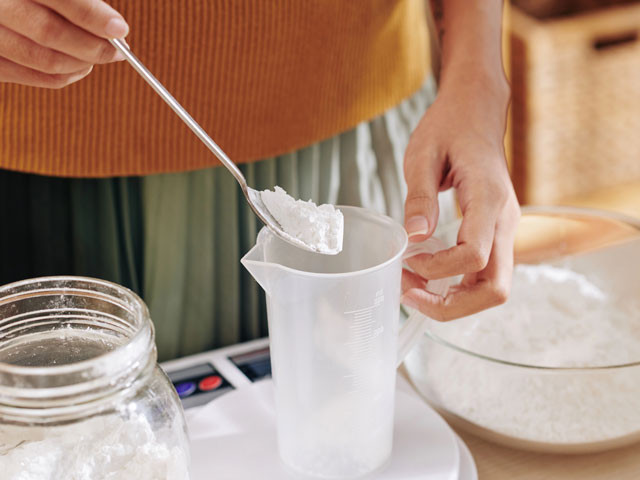What Is Lye Soap Made Of
Lye is a strong alkaline chemical compound, specifically referring to sodium hydroxide (NaOH) or potassium hydroxide (KOH). These substances are highly caustic and have been used historically in manufacturing soap, paper, and various cleaning products.

From a chemical perspective, lye has a high pH level (typically around 13-14) and readily reacts with fats through a process called saponification, which is the primary chemical reaction in traditional soap making.
The Production of Lye
Historical methods of lye production involved leaching wood ashes with water. And it's true, some apothecaries and soap makers still occasionally use this method in small-scale, artisanal batch soap. But in today's day and age, who really has time for ancient methods? Not us.
The chloralkali process is the primary way lye gets produced commercially today. In this process, an electric current passes through a sodium chloride (table salt) solution, producing sodium hydroxide (lye), chlorine, and hydrogen gas. The alternative is the electrolysis method, which involves passing an electric current through a solution of sodium chloride between two electrodes.
Those are just fancy ways of saying you should source your soap making lye from the store. Besides, you don't have the commercial grade equipment, nor the energy (pardon the pun) to deal with the need for large-scale waste removal.
The history of Lye in Soap Making
Soap Makers might be among humanity's first attempts at establishing a Henry Ford style assembly line of manufacturing.
In ancient Mesopotamia, around 2800 BCE, archaeological evidence shows that people had discovered the basic process of combining animal fats with wood ash (containing potassium hydroxide, a form of lye) to create a cleaning agent. The earliest written soap recipe, found on a Babylonian clay tablet from approximately 2200 BCE, describes this cold process soap making method.
The Romans further developed soap-making techniques during their empire. They established large-scale production facilities, particularly in regions with abundant olive oil supplies. These Roman manufacturers, fancy as they might have been, experimented with different oils and scents to create a wider variety of soap.
So early manufacturing to early commerce. Got it.
During the Middle Ages, soap making became a regulated guild craft in Europe. The process evolved to include more precise measurements and quality controls. SCIENCE!
Soap makers discovered that different types of ashes produced varying qualities of lye, with hardwood ashes generally yielding superior results. Cities like Castile in Spain and Marseille in France became renowned centers of soap production. We haven't heard of Marseille Soap, but we sure know about Castile Soap.
The industrial revolution marked more evolution in the soap manufacturing process. In 1791, Nicolas Leblanc developed a process for manufacturing sodium hydroxide (lye) from common salt, making pure lye more readily available. This innovation, combined with better understanding of the chemistry involved, led to more consistent and higher-quality soap production.
It also led to cleaner and better smelling humans. A win for humanity at large, we'd say.
Commercial Manufacturers now use pure sodium hydroxide or potassium hydroxide, allowing for exact measurements and consistent quality. This scientific approach has enabled the development of specialized soaps for various applications, from gentle personal care products to industrial cleaning agents.
How Do You Add Lye To Make Soap?
With caution! Here are a few simple steps to give you an idea of how one can add lye to make soap. If you want to know more, check out our Cold Process Instructions.
- Safety above all. Wear chemical-resistant gloves, goggles, long sleeves, and work in a well-ventilated area. Keep vinegar nearby to neutralize any spills.
- Precisely Measure. Calculate exact amounts using a soap calculator. Never estimate.
- The Mixing Process. Add lye to cold water using stainless steel containers. Mix slowly. Let cool.
- Combine with Oil. Pour lye solution slowly onto oils. Stir to trace.
- Curing. Pour into molds and wait a month.
Keep away from children and pets. Also, when working with chemicals, always exercise caution.
Frequently Asked Questions (FAQs)
Is Lye soap safe?
Properly made and fully cured lye soap is safe to use, as the lye fully reacts with oils during saponification, leaving no active lye in the final product. Uncured or improperly made lye soap can cause skin irritation or chemical burns.
Is Lye good for your skin?
No. Pure lye is extremely dangerous for skin contact and can cause severe chemical burns. Even diluted lye in uncured soap can be harmful. Only in fully cured soap, where the lye has completely reacted with oils (saponification), is it safe for skin use. Any direct skin contact with lye should be immediately washed with water.
Can you make soap without lye?
No true soap can be made without lye, as the chemical reaction between lye and fats (saponification) is what creates soap. Products marketed as "lye-free soap making" typically use pre-made soap bases, which have already undergone the lye reaction during manufacturing.
Can You Make Goat Milk Soap Without Lye?
Technically, yes, but only if you rebatch the goat milk soap. Same goes for Donkey Milk Soap.